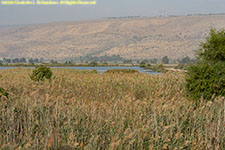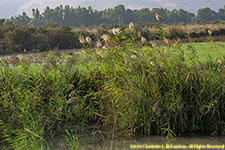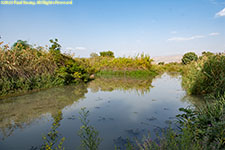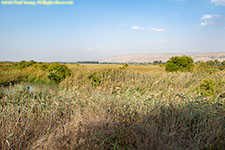



The Hula Valley's lake and wetlands form an important resting place for migrating birds moving between Europe and Africa. The original wetland was drained in 1951, with a small area set aside as the first nature reserve in Israel in 1964. Agriculture in the reclaimed peatlands was causing chemical runoff pollution at the Sea of Galilee as well as ground subsistence and even underground fires as the peat dried out, so another larger area north of the reserve was reflooded in 1994 and became a major tourist attraction, Agamon-HaHula, for bird-watchers during the spring and fall migrations.
Egrets and herons:
Cattle egret, Bulbulcus ibis
Great white egret, Egretta alba
Grey heron, Ardea cinerea
Night heron, Nycticorax nycticorax
Cranes:
Common crane, Grus grus
Plovers:
Spur-winged plover, Vanellus spinosus
Doves:
Rock pigeon, Columba livia
Eurasian collared-dove, Streptopelia roseogrisea
Ducks:
Mallard, Anas platyrhynchos
Gallinules:
Common (Eurasian) moorhen, Gallinula chloropus (adult left, juvenile right)
Eurasian (Common) coot, Fulica atra
Cormorants:
Great cormorant, Phalacrocorax carbo
Pygmy cormorant, Microcarbo pygmaeus
Pelicans:
White pelican, Pelecanus onocrotalus
Corvids:
Raven, Corvus corax
Bulbuls:
White-spectacled bulbul, Pycnonotus xanthopygos
Ibises:
Glossy ibis, Plegadis falcinellus
Kingfishers:
Common kingfisher, Alcedo atthis
White-throated kingfisher, Halcyon smyrnensis
Pied kingfisher, Ceryle rudis
Larks:
Mediterranean short-toed lark, Alaudala rufescens
Other creatures:
Dragonfly
Crab
Nutria (coypu), Myocastor coypus
Egyptian catfish
©2022 Mermaid Underwater Photographic. All Rights Reserved.
This page sponsored by Mermaid Underwater Photographic. Contact us at mermaid@underwater.org.
Last modified 30 November 2022